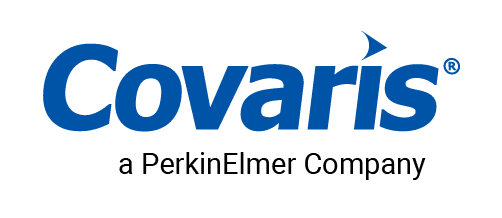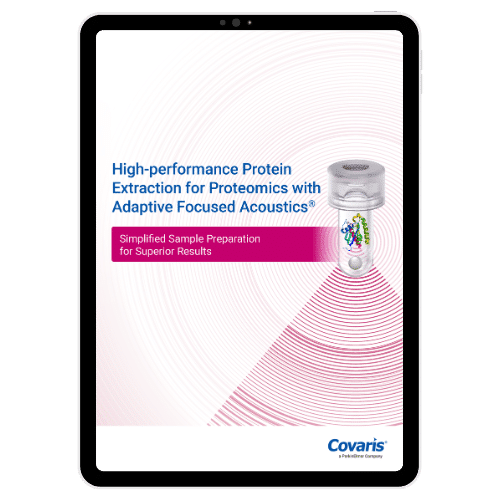A large number of experiments in biosciences require high-quality protein samples.
While sonication is a go-to method for breaking open cells, traditional probe and bath sonication come with frustrating downsides, such as heating your samples, cross-contamination, inconsistent results, and workflows that you cannot streamline or automate.
This article introduces a superior method, called Adaptive Focused Acoustics® (AFA®), to extract proteins from virtually any sample type.
Read on to learn how AFA can provide reproducible protein yields and increased protein coverage from a broad range of sample types, minimizing heat generation within your samples in a non-contact environment.
Common Uses of Proteins in Bioscience
Protein samples are the basis for a huge range of studies and techniques in bioscience. Downstream applications that require extracted proteins include:
- Proteomics
- Structural studies
- Protein-protein interactions
- Enzyme activity assays
- Post-translational modification analysis
Challenges of Protein Extraction
Scientists working with extracted proteins need a robust extraction method that supports their intended analysis.
There are many methods to extract proteins from different sample matrices, each with advantages and limitations.
Choosing the most suitable method can be complicated because the key properties of proteins, such as charge, molecular mass, hydrophobicity, structure, function, and expression levels, are diverse.
Plus, protein structures are thermally sensitive and, therefore, must be handled at a controlled temperature.
Factors that influence your protein extraction method include:
Sample Source Type
For example, formalin-fixed, paraffin-embedded (FFPE) tissue will need thorough deparaffinization before any protein can be extracted.
Other protein sources, such as fresh frozen (FF) tissue samples, require thorough homogenization due to their rigidity, while different cell culture types (adherent or suspension cells) impact the approach to cell lysis.
Starting Sample Volume
Large amounts of starting material result in a viscous sample that’s difficult to homogenize. Low amounts increase the risk of missing low-abundance proteins, especially considering the multiple transfer steps often involved in protein extraction protocols.
Target Protein Type
Some extraction methods may not efficiently extract specific protein types, such as those embedded in membranes or proteins that exist as complexes.
Intended Application
The ultimate goal of your protein extraction influences whether a given protein extraction method is suitable. For example, structural studies and activity assays require a protein extraction method that limits heat damage or only uses mild chemicals.
Using Bath or Probe Sonication for Protein Extraction
Bath and probe sonication are commonly used to physically disrupt cells and release proteins using acoustic energy.
How Sonication Works
In bath and probe sonicators, low-frequency, unfocused acoustic energy causes localized pressure fluctuations in the surrounding liquid.
These fluctuations lead to the formation of cavitation bubbles, which expand and collapse, generating hydrodynamic shear forces in the medium. These forces propagate through the liquid and disrupt nearby cells, leading to membrane rupture and the release of biomolecules.
Sonication has advantages over other mechanical cell lysis methods, such as bead beating or using a mortar and pestle. For example, it can shear DNA during lysis, reducing sample viscosity and making the extract easier to process.
Disadvantages of Bath and Probe Sonication
While sonication is a popular choice for protein extraction, it has some major limitations. These include:
- Heat production can denature and degrade your sample
- Cross-contamination can occur between users
- It has limited scalability for large sample sizes
- It’s difficult to automate
- It can make your sample foam
- It often produces inconsistent results between samples
- It’s noisy
Superior Protein Extraction with AFA Ultrasonication
AFA technology by Covaris is a mechanical mechanism for breaking open cells using highly focused acoustic energy.
The method is efficient and reproducible and uses high-frequency acoustic energy in a temperature-controlled, non-contact environment; there is no need to insert a probe into the sample.
How AFA is Different from Traditional Sonication
Although AFA uses acoustic energy like sonication, the latter uses much lower frequencies and unfocused acoustic energy.
Typical probe and bath sonicators operate at frequencies between 10-30 kHz, which is on the edge of the audible range.
At this frequency, the wavelength is approximately 100 mm, which is longer than a typical sample vessel (~10–100 mm).
The acoustic energy of this wavelength cannot be focused into the sample vessel. In contrast, AFA delivers highly focused acoustic energy at higher, tunable frequencies, enabling precise control over energy delivery to suit a wide range of sample types.
It is also beyond the audible range, making it silent to the user.
How AFA Works
The ultra-high frequency electronics and transducers produce acoustics with a wavelength of only a few millimeters.
Short acoustic wavelengths enable the convergence of energy into a small focal zone within the sample vessel (Figure 1), and this efficient energy delivery minimizes heat generation.
The Covaris Focused-ultrasonicator systems have multiple transducer configurations that enable single-sample or parallel processing of multiple samples in the acoustic focal zone.

Benefits of Adaptive Focused Acoustics
Adaptive Focused Acoustics technology overcomes many of the challenges associated with sonication and is a superior choice for protein extraction. Its primary benefits include:
- Heat production is precisely controlled to prevent degradation
- The acoustic energy is focused thanks to short wavelengths
- The non-contact environment prevents cross-contamination
- It delivers reproducible results
- It can be automated
- It’s scalable
- It’s silent
- It supports a wide variety of sample types and vessel formats
Because AFA enables tunable acoustic energy to be delivered in a controlled, non-contact environment, you can tailor the extraction conditions to accommodate different protein properties, such as hydrophobic membrane proteins or delicate protein complexes.
The ability to modulate energy input ensures efficient lysis and homogenization across a broad range of sample types without compromising protein integrity or yield.
Table 1 below compares AFA to probe and bath sonication.
Table 1. A comparison of the key parameters of sonication across AFA, probe, and bath sonication methods.
Parameter | AFA (Adaptive Focused Acoustics) | Probe/Bath Sonication |
Acoustic Energy Type | Focused, high-frequency | Unfocused, low-frequency |
Frequency Range | 0.5–1.0 MHz | 10–30 kHz |
Contact with Sample | Non-contact | Direct (probe) or indirect (bath) |
Heat Generation | Minimal, precisely controlled | High, often uncontrolled |
Risk of Cross-Contamination | None (closed vessel) | High (probe systems) |
Reproducibility | High | Variable |
Sample Volume Range | Broad (low to high volumes) | Limited |
Scalability & Automation | Highly scalable, automation-ready | Limited scalability, hard to automate |
Noise Level | Silent | Noisy |
Suitability for Sensitive Proteins | Excellent | Poor (due to heat and shear) |
Processing Throughput | High (parallel processing) | Low to moderate |
Tunable Energy Input | Yes | No |
Sample Foaming Risk | None | Common |
Here are some examples of how researchers are benefiting from using AFA-based protein extraction.
Get High Protein Yields from Low Cell Numbers
The non-contact environment and gentle sample treatment have been demonstrated to preserve protein integrity and proteomic coverage, even when processing as few as 1,000 cells [2].
Improve Your Protein Yields
AFA-based methods make protein extraction from FFPE tissue simple thanks to streamlined deparaffinization, decrosslinking, and homogenization steps. This can reduce sample preparation time from seven days to just two days [3].
Achieve Reproducible Results Across Sample Types
Not only does AFA technology ensure reproducible protein yields, but this level of repeatability is also possible across multiple tissue types. For example, studies have shown that it’s possible to obtain reproducible numbers of protein groups from multiple tissue types from a single source across multiple days using AFA-based methods for tissue homogenization [4].
Scale Up and Automate Your Protein Extraction
Traditional mechanical cell lysis methods are difficult to automate because they are incompatible with multiple well formats. AFA technology is compatible with 96-well plates, making it suitable for the introduction of robotics into the protein extraction workflow [5].
Process a Broad Range of Sample Types
AFA-based protein extraction methods are compatible with a wide range of common sample types:
- Fresh frozen tissue [6]
- FFPE tissue, [7,8] including scrolls and deparaffinized slide scrapings
- Laser capture microdissection samples
- Mammalian cells [9,10]
- Bacterial cells [11]
- Yeast [12]
Adaptive Focused Acoustics for Protein Extraction Summarized
Optimized protein preparation is essential to achieve scalability for high-throughput laboratories and is often desirable in low-throughput labs because expressing and isolating proteins is a lengthy process.
Covaris AFA technology provides an efficient and reproducible protein extraction method.
It preserves sample quality, enables high-throughput workflows, and accommodates diverse sample types to provide a streamlined bridge between sample processing and reliable, impactful downstream analyses.
To learn more about how you can achieve broader proteome coverage, higher yields, and reliable extraction of proteins for your proteomics workflow using AFA®, download the free eBook below.
References
- Covaris Adaptive Focused Acoustics® (AFA®) Technology. URL: https://www.covaris.com/technology/afa-technology (Accessed 31 March 2025)
- Jain A, Charlesworth CM, Sachdeva G Vasantgadkar S, Bhattacharyya D, Pandey A. (2024, June 2-6). Proteomics Analysis of a Limited Number of Cells by a Rapid and Efficient Workflow using Adaptive Focused Acoustics Technology [Conference presentation and poster]. American Society for Mass Spectrometry 72nd Conference on Mass Spectrometry and Allied Topics (ASMS) 2024, Anaheim, California, United States
- Haines M, Thorup J, Gohsman S, Heil L, Vasantgadkar S, Abarzua L, Newton C, Rohrer D, Hostetter G, Mani DR, Gillette MA, Carr SA, Satpathy S (2024, June 2-6). High-throughput, streamlined processing workflow of formalin-fixed paraffin-embedded (FFPE) tissue yielding up to 10,000 proteins per sample [Conference presentation and poster]. American Society for Mass Spectrometry 72nd Conference on Mass Spectrometry and Allied Topics (ASMS) 2024, Anaheim, California, United States
- Ortiz J, Keoseyan A, Bhosale DS, Hendricks N, Seyedmohammad S, Stotland A, Vasantgadkar S, Abarzua L, Moradian A, Mockus S, Van Eyk J. (2024, June 2-6). High-throughput and automated cellular and tissue lysis using COVARIS acoustic technology for proteomics [Conference presentation and poster]. American Society for Mass Spectrometry 72nd Conference on Mass Spectrometry and Allied Topics (ASMS) 2024, Anaheim, California, United States
- Braun C, (2024, June 2-6). Leveraging Plate-Based AFA For Robust and Consistent High Throughput Proteomics [Conference presentation]. American Society for Mass Spectrometry 72nd Conference on Mass Spectrometry and Allied Topics (ASMS) 2024, Anaheim, California, United States
- Covaris. microTUBE-130 Bead Snap-Cap. URL: www.covaris.com/microtube-130-bead-snap-cap. (Accessed April 4, 2025)
- Covaris. FFPE Extraction, FFPE Paraffin Removal and Extraction. URL: www.covaris.com/ffpe-extraction. (Accessed April 4, 2025)
- McCarthy P, Beker L, Vasantgadkar S, Pundt E, Daviso E, Thomann U, Bhattacharyya D. (2024 June 2-6). Comprehensive Sample Prep Workflow for Deparaffinization, Extraction, Purification, & Accelerated Digestion of Proteins from Formalin-Fixed Paraffin-Embedded Tissue [Poster] American Society for Mass Spectrometry (ASMS) 72nd Conference on Mass Spectrometry and Allied Topics 2024, Anaheim, California, United States
- Covaris. truPREP Protein 12×8 Strip Kit – Mammalian Cells (Lysis, Extraction, Digestion). URL: http://www.covaris.com/truprep-protein-12×8-strip-kit-mammalian-cells-lysis-extraction-digestion. (Accessed April 4, 2025)
- McCarthy P, Vasantgadkar S, Pundt E, Daviso E, Thomann U, Bhattacharyya D. (2024 June 2-6) Comprehensive Workflow for Extraction, Purification, and Accelerated Digestion of Proteins from Mammalian Cells [Poster] American Society for Mass Spectrometry (ASMS) 72nd Conference on Mass Spectrometry and Allied Topics 2024, Anaheim, California, United States
- Covaris. (2019). Lysis and Extraction of Biomolecules from Eukaryotic and Prokaryotic Cells Powered by AFA-energetics® (Technical Note M020114_RevB_Jun2019). URL: https://www.covaris.com/wp/ wp-content/uploads/resources_pdf/M020114.pdf (Accessed April 4, 2025)
- Smejkal G, Skea W, Khoja H, Laugharn J. (2019). Active Extraction of Native Proteins from Yeast using Covaris Adaptive Focused Acoustics® (AFA®) (Application Note M020021_RevA_May2016). URL: https://www.covaris.com/wp/wp-content/uploads/resources_pdf/M020021.pdf (Accessed April 4, 2025)








